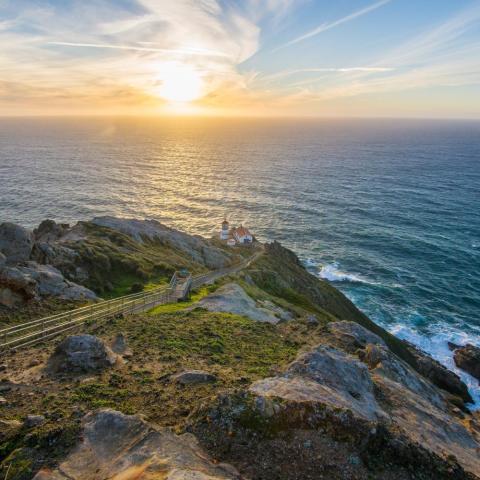
Artist’s impression of how it may have looked from the village site overlooking Coral Cove (Corral Harbor) when Russians and Alaska Natives were on the island hunting sea otters/Illustration by Michael Ward
In the best-selling children’s novel Island of the Blue Dolphins, the lead character was a Native American woman left on San Nicolas Island by herself from 1835 to 1853. The story, it turns out, was not entirely fiction.
During a special lecture at Channel Islands National Park on Thursday, December 13, a panel of researchers will reveal information about why the Lone Woman remained on San Nicolas Island after others in her community left for the mainland.
Steven Schwartz, Dr. John Johnson, Susan Morris, and Carol Peterson have examined evidence revealing that the Lone Woman stayed on the island to take care of her son. She lived with him for a number of years before he was tragically killed in a boating accident, after which she was truly alone.
Contrary to previous belief, it is now understood that when the Lone Woman was brought to the mainland there were native speakers in Santa Barbara who were able to effectively communicate with her through spoken word. She shared with them why she chose to stay on the island as the others left.
Steven J. Schwartz, recently retired, was the Navy’s senior archaeologist on San Nicolas Island for 25 years. Due to this unique position, he has become one of the leading experts on the Lone Woman’s story, publishing and speaking on this topic at numerous venues.
Dr. John R. Johnson has served as curator of anthropology at the Santa Barbara Museum of Natural History for 30 years. He obtained his Ph.D. at UCSB, where he's an adjunct professor of anthropology. His written contributions include more than 80 studies of the culture and history of California’s native peoples, especially emphasizing the Chumash Indians of the Santa Barbara region.
Susan L. Morris is an independent historical researcher and writer. She has worked on seven of the eight Channel Islands (including San Nicolas Island) on archaeology, paleontology, geology, and biology projects. For the past eight years, Morris has focused her research on the Lone Woman of San Nicolas Island, contributing content to the new National Park Service Island of the Blue Dolphins website.
Carol Peterson was the education coordinator at Channel Islands National Park for 16 years and was the main project coordinator for the Island of the Blue Dolphins website. Since her retirement, she has continued to coordinate this project as a volunteer and is responsible for posting all content on the website.
The talk will take place at 7 p.m. at the Channel Islands National Park Robert J. Lagomarsino Visitor Center, 1901 Spinnaker Drive, in Ventura Harbor, California. The program is free. If you can't make the lecture, it will be recorded for viewing on this site.




 Support Essential Coverage of Essential Places
Support Essential Coverage of Essential Places







Comments
So where are the pictures? It's rather like listening to music without sound.
I think you should read Island of the Blue Dolphins by Scott O'Dell and look up th true story of the lost women on san Niclus Island